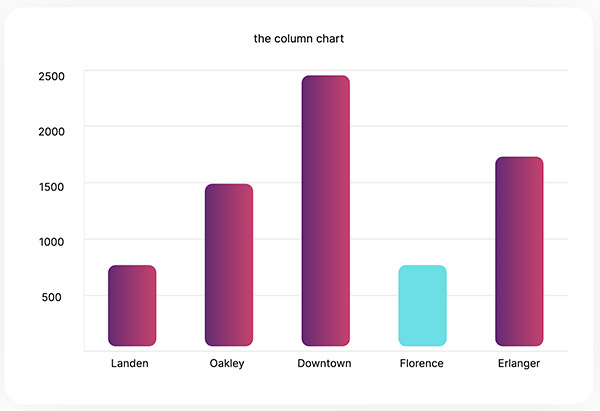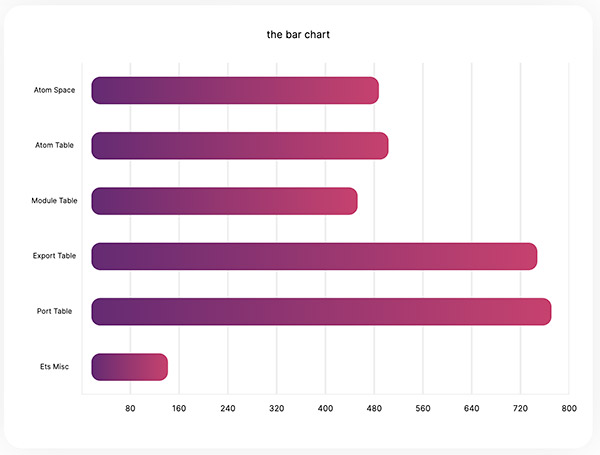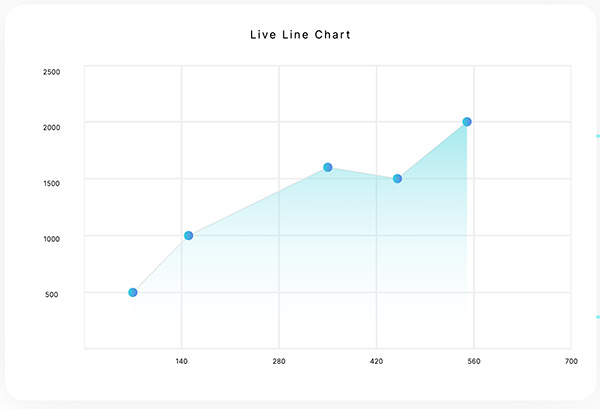Uncharted Phoenix
A simple Elixir charting library that generates easy to customize charts for Phoenix and LiveView.
Features
- Easily generate pie charts, column charts, bar charts, progress counters, and line charts
- Generates responsive and accessible SVGs as LiveView components
- Provides advanced styling like gradients and rounded corners
- Smooth animations for updating live data to the UI
HEX Installation
Add this to your mix.exs deps:
{:uncharted_phoenix, "~> 0.1.0"}
How To Use
The Column Chart

column_chart = %BaseChart{
title: "Cheese Coney Consumption by Neighborhood",
colors: colors,
dataset: %ColumnChart.Dataset{
axes: %BaseAxes{
magnitude_axis: %MagnitudeAxis{
max: 10_000,
min: 0
}
},
data: Cincy.get()
}
}The Bar Chart

defp bar_chart do
memory_data = MemoryChart.get()
data = MemoryChart.convert_to_datum(memory_data)
%BaseChart{
title: "Live Beam Memory Stats",
colors: %{
blue: "#36D1DC",
rosy_gradient: %Gradient{
start_color: "#642B73",
stop_color: "#C6426E"
}
},
dataset: %BarChart.Dataset{
axes: %BaseAxes{
magnitude_axis: %MagnitudeAxis{
max: MemoryChart.chart_max(memory_data),
min: 0
}
},
data: data
}
}
endThe Pie Chart

pie_chart = %BaseChart{
title: "Best kind of pie",
colors: %{
rose_gradient: %Gradient{
start_color: "#642B73",
stop_color: "#C6426E"
},
blue_gradient: %Gradient{
start_color: "#36D1DC",
stop_color: "#5B86E5"
},
red_gradient: %Gradient{
start_color: "#FF9486",
stop_color: "#FF1379"
}
},
dataset: %PieChart.Dataset{
data: [
%BaseDatum{
name: "Pecan",
fill_color: :red_gradient,
values: [20.0]
},
%BaseDatum{
name: "Blueberry",
fill_color: :blue_gradient,
values: [28.0]
},
%BaseDatum{
name: "Pumpkin",
fill_color: :rose_gradient,
values: [35.0]
},
%BaseDatum{
name: "Chocolate",
fill_color: :blue_gradient,
values: [17.0]
}
]
}
}The Line Chart

line_chart = %BaseChart{
title: "Live Line Chart",
colors: colors,
dataset: %ColumnChart.Dataset{
axes: %XYAxes{
x: %MagnitudeAxis{
max: 700,
min: 0
},
y: %MagnitudeAxis{
max: 2500,
min: 0
}
},
data: [
%BaseDatum{
name: "Point 1",
fill_color: :blue_gradient,
values: [70, 500]
},
%BaseDatum{
name: "Point 2",
fill_color: :blue_gradient,
values: [150, 1000]
},
%BaseDatum{
name: "Point 3",
fill_color: :blue_gradient,
values: [350, 1600]
},
%BaseDatum{
name: "Point 4",
fill_color: :blue_gradient,
values: [450, 1500]
},
%BaseDatum{
name: "Point 5",
fill_color: :blue_gradient,
values: [550, 2000]
}
]
}
}The Progress Chart

defp progress_chart(from: %BaseChart{} = chart) do
memory = Memory.get()
%BaseChart{
chart
| title: "Process Memory / Total",
colors: %{
rose_gradient: %Gradient{
start_color: "#642B73",
stop_color: "#C6426E"
},
blue_gradient: %Gradient{
start_color: "#36D1DC",
stop_color: "#5B86E5"
},
red_gradient: %Gradient{
start_color: "#FF9486",
stop_color: "#FF1379"
},
gray: "#e2e2e2"
},
dataset: %ProgressChart.Dataset{
background_stroke_color: :gray,
label: "Proc Memory",
secondary_label: "(% Of Total)",
to_value: memory.total,
current_value: memory.process,
percentage_text_fill_color: :blue_gradient,
percentage_fill_color: :rose_gradient,
label_fill_color: :rose_gradient
}
}
endBase Chart Colors
Base chart configuration allows you to define set solid colors and gradients for any chart you will use within the application.
Set a Base Color
colors = %{
blue: "#6bdee4"
}Set a Base Gradient Color
colors = %{
rose_gradient: %Gradient{
start_color: "#642B73",
stop_color: "#C6426E"
}
}